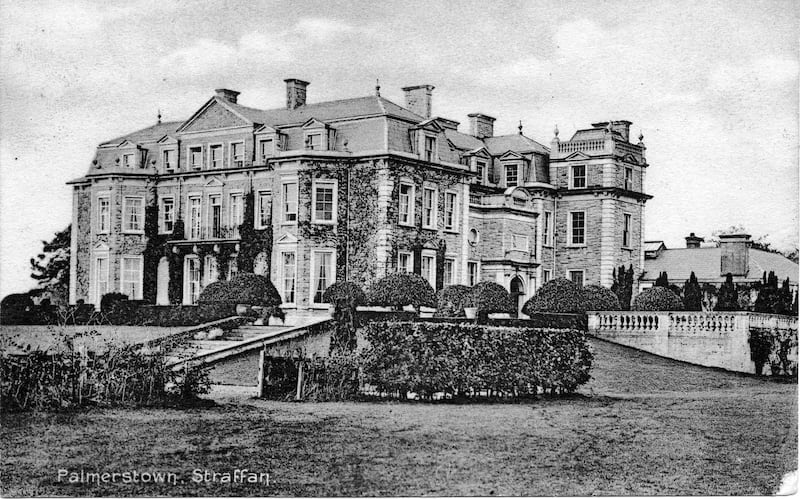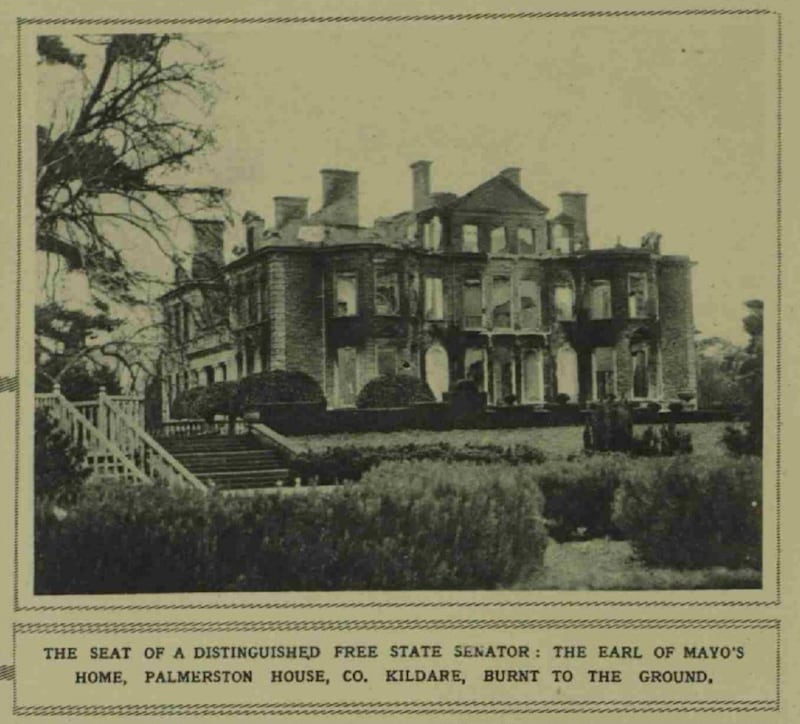On January 29th, 1923, on a stormy winter’s night, a group of armed and disguised anti-treaty Irish Republican Army (IRA) members arrived at the earl of Mayo’s Palmerstown House in Co Kildare.
[ Read the complete Century: 1923 Birth of a Nation seriesOpens in new window ]
Dermot Bourke, 7th earl of Mayo; his wife; and a number of servants were present. The men forced their way into the house and told Lord Mayo they had orders to burn his house in retaliation for the execution of a number of their comrades by the Free State forces.
Lord Mayo was given 20 minutes to save what he could. He only managed to save three paintings by Sir Joshua Reynolds, two by Titian, and most of his hunting clothes. The raiders then entered the diningroom, moved all the heavy furnishings into the centre of the room, and saturated them with petrol before setting the pile alight. Soon the whole house was in flames. Lord Mayo and his wife were guarded by two of the IRA men and left unharmed. He later recalled: “It is only right to say that the raiders were excessively polite.”
The Curragh military fire brigade arrived around midnight but it was too late. Ceiling after ceiling had by then collapsed with deafening noise, cut-stone window facings and turrets had split with the heat and flown in splinters to the ground. The local newspaper reported that “priceless treasures” had been lost including superb collections of Chippendale and Sheraton furniture. Many of the family portraits were burned as well as all the family and estate records, representing a great loss to the history of the local community.
READ MORE

In all, almost 300 big houses were destroyed in the War of Independence (1920-21) and the Civil War (1922-23) in what is now the Republic of Ireland. The burnings were most heavily concentrated in the main theatres of war, especially the southern counties of Munster, and especially Cork and Tipperary.
Big houses were the homes of the former Anglo-Irish landlord class. Most of them dated from the early 18th century. Landlords had sold most of their lands to their tenants before the outbreak of the first World War in 1914. While many of them decided to leave after this, hundreds still remained in Ireland, hoping to make a living on their investments and farmland. As staunch unionists, the vast majority also hoped Ireland would remain part of the United Kingdom.
Perhaps the greatest architectural loss was the magnificent Palladian mansion, Summerhill House, in Co Meath. It was burned on February 4th, 1921, when the local IRA heard a rumour it was to be occupied by the Black and Tans
Because they supported the British administration, big house owners were regarded as enemies of the emerging revolutionary state. The big house was seen as the physical symbol of conquest and colonial oppression that had begun hundreds of years before. This was compounded in the early days of the War of Independence when many abandoned houses were commandeered by the crown forces and used as billets because the IRA had burned so many rural RIC barracks. Perhaps the greatest architectural loss was the magnificent Palladian mansion, Summerhill House, in Co Meath. It was burned on February 4th, 1921, when the local IRA heard a rumour it was to be occupied by the Black and Tans.
As the War of Independence intensified, big houses became caught up in the spiralling violence of reprisal and counter-reprisal that characterised the conflict between the IRA and crown forces. Cork IRA leader Tom Barry later wrote: “Castles, mansions and residences were sent up in flames by the IRA immediately after the British fire gangs had razed the homes of Irish republicans ... If the republicans of west Cork were to be homeless and without shelter, then so too would be the British supporters.”
However, it is important to remember that it is often very difficult to unravel complex and interlocking reasons, some contemporary, others buried in the historical past. In July 1921, Lord Castlemaine’s Moydrum Castle in Co Westmeath was burned by the IRA in revenge for the burning of several farmhouses by crown forces in revenge for the killing of Col Thomas Lambert in an IRA ambush near Coosan on June 20th. However, the recent involvement of the local IRA leader in land disputes also suggested an agrarian reason – the struggle for land. Many aristocratic landlords such as Lord Castlemaine had held on to hundreds of acres of demesne lands. In 1924, after further destruction to his estate, he decided to sell all of his lands to the Irish Land Commission who then divided them among local small farmers.
The hunger for land became more intense in the Civil War and goes some way to explaining why there were about 2½ times more houses burned in that war (199) than in the War of Independence. By then there was an almost complete absence of all forces of law and order in the countryside following the withdrawal of the crown forces in 1922 and the disbandment of the RIC. The county inspector of Tipperary saw the danger coming a month after the truce was called in July 1921: “The hunger for land is great, those who are landowners want more, while those who have none and who have been gunmen believe that the estates of loyalists such as Kilboy once cleared will be divided up amongst them.” Kilboy was burned on August 4th, 1922.

There were, of course, other reasons for the big rise in the number of burnings. Vacated houses such as the huge Mitchelstown Castle in Cork were used as billets and barracks by anti-treatyites and then destroyed before they were evacuated as the Free State army approached.
While they were in the castle, officers used the back of oil canvases to draw maps, books from the library were used as substitutes for sandbags in the windows, and there was even a claim that men used shards of glass to play darts on a Rembrandt painting.
On September 28th, 1922, a public safety resolution was sanctioned by the provisional government, which established military courts of inquiry that were authorised to impose death sentences on captured anti-treatyites found guilty of attacks against the National Army, or offences related, for example, to looting, arson, unlawful possession of arms or damage to public or private property. On December 19th, 1922, seven anti-treatyites were executed in Kildare, the largest individual set during the Civil War. The following month 34 executions took place, the highest recorded figure for any month.
Those aristocratic senators, such as Lord Mayo at Palmerstown, who had chosen to support the new regime, now found their houses being targeted for yet another reason. On January 26th, all anti-treatyite Divisions were issued with “Operation Order No 16: Senators” by GHQ in Dublin. It stipulated that houses of Free State senators were to be burned as reprisals for executions of anti-Treatyite prisoners.
Moreover, in early February, the chief of staff of the anti-treaty IRA, Liam Lynch, declared that the IRA would “hold every member of the so-called Parliament, Senate and other House, and all other Executives responsible [for the executions], and shall certainly visit them with the punishment they deserve.”
In the weeks that followed, Palmerstown along with several other senators’ houses were burned. These included Sir John Keane’s Cappoquin in Waterford (though in this case agrarian motives were also lurking in the background); Moore Hall in Mayo; and Sir Thomas Esmonde’s Ballynastragh in Wexford.

Destruction was very often accompanied by looting. Lord Dunalley “heard on excellent authority” that the contents of his home Kilboy in Tipperary were in many of the local farmhouses in the neighbouring locality. In October 1924, his solicitor advised him not to try to get them back: “It would be putting you in a most invidious position and would, I think, cause great ill feeling, which has now happily died down.”
Ruins such as Palmerstown, Tyrone House in Galway and Moore Hall in Mayo stood like ghostly figures for generations to come, regarded by most nationalists in post-independent Ireland as iconic symbols of a victory over the former coloniser. For generations, it was difficult to see beyond this to contemplate their heritage value.
Terence Dooley is professor of history at Maynooth University and author of the best-selling Burning the Big House: The Story of the Irish Country House in a Time of War and Revolution (Yale University Press, 2022)
In the classroom:
Who owned the big houses?
Big houses were the homes of the former Anglo-Irish landlord class. Most of them dated from the early 18th century. Landlords had sold most of their lands to their tenants before the outbreak of the first World War in 1914. While many decided to leave after this, hundreds still remained in Ireland, hoping to make a living on their investments and farmland. As staunch unionists, the vast majority also hoped that Ireland would remain a part of the United Kingdom.
Demesne lands: what were they?
Demesne lands were the private lands around the big house, often enclosed by high stone walls. Even though the British land acts had transferred the ownership of almost 80 per cent of Irish land, a very high percentage of farms all over the country were too small and unviable to support a family.
Who were loyalists?
Loyalists at the time were men and women who continued to support the British administration in Ireland and who did not want an independent Ireland.
How to research a big house in your area
There are hundreds of ‘big houses’ scattered across the country. Some were attacked and destroyed, others were rebuilt and many escaped intact.
* Newspapers: Online archives provide a wealth of material. The Irish Times archive (irishtimes.com/archive) and the Irish Newspaper Archive (irishnewsarchive.ie), which schools have access to via Scoilnet.
* Civic records: County libraries, museums and local history societies often have records pertaining to local big houses.
* National Library: The National Library of Ireland (nli.ie) holds records of big houses and landed estates from all over the island of Ireland, with material dating back hundreds of years. In addition, the Public Record Office of Northern Ireland (nidirect.gov.uk) in Belfast holds the largest collection of estate records in Northern Ireland, with many estate records for big houses in the Republic as well. For an introduction, look up the leaflet on “landed estate records”.
* Books: A good starting point to the very many sources available is Terence Dooley’s The Big Houses and Landed Estates of Ireland: A Research Guide (Four Courts Press, 2007)
* Building records: The Irish Architectural Archives (iarc.ie) has material on country houses.
* Heritage Ireland: Its Stately homes provides details on houses in state care. Also, Robert O’Byrne’s website theirishaesthete.com has valuable material and images from across Ireland.
* The Military Archives: These archives (militaryarchives.ie/) have lots of records, including IRA witness statements and pension files
* Universities: Maynooth University’s Centre for the Study of Historic Irish Houses and Estates has a wealth of information.
















